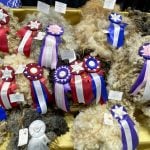Life is good for the Clydesdale geldings working for the Anheuser-Busch
brewing company.
Regular bathing, combing, massage, managed health care and ideal
rations probably make Budweiser beer wagon duties a pleasure as the
teams criss-cross North America for 330 days each year.
Three teams of 10 horses each, their drivers and seven grooms travel
about 50,000 kilometres visiting fairs, rodeos, ski hills and sporting
events, while showing off a scarlet painted wagon full of wooden
Budweiser beer boxes. Another three teams are permanently working at
Read Also

Beef cattle more prone to trace mineral deficiencies
The trace mineral status of our cows and calves is a significant challenge for western Canadian producers and veterinarians.
theme parks in California, Florida and Texas.
Lead driver Lloyd Ferguson, who says he is still learning his trade
after 23 years, travels throughout the year with his team. They have
performed at the Salt Lake City Olympics, drag races in Colorado, the
Ponoka Stampede and numerous parades.
His favourite time is working one on one with the massive animals.
“I like working with them in the stall. You can see if anything is
going to affect the way they drive,” he said during a visit to the
Calgary Stampede.
Getting a horse on the team is a coup for many Clydesdale breeders.
E-mails and photos flood into Budweiser every year as breeders from
across North America and the United Kingdom hope to place a horse on
the elite team.
“Breeders know if they have a good prospect. Probably three to four
make it,” he said.
At this year’s Calgary Stampede, the two lead geldings on the hitch
were from Virden, Man.
At 300 horses, the Anheuser-Busch Clydesdale herd is the largest in the
world. Two breeding farms are maintained in California, producing about
50 colts each year. Not all win a spot on one of the six teams.
Each horse must be gelded and stand 18 hands high (72 inches) at the
shoulder. It should weigh 2,000-2,300 pounds. All horses are bays with
four white feet, a white blaze on the face and black manes and tails.
The first criteria in the breeding program are good conformation and
easy going temperament. Colour is never guaranteed.
“The genetics of colour is difficult to breed for. With Clydesdales, if
you try and breed a solid bay to a solid bay, you might get speckles,”
said Ferguson.
Potential wagon horses may be selected when they are as young as
yearlings. Training takes from six months to a year and they start work
when they are four.
Some horses have worked until they reach age 19. When they get older,
they are put out to pasture and are often used to train colts.
“It’s good to have old horses that are real steady to teach these young
colts,” said Ferguson.
Clydesdales have represented the giant brewer Anheuser-Busch since 1933
when the first eight-horse hitch went on parade in St. Louis, Missouri,
to commemorate the repeal of prohibition in the United States. The
horses were selected for their showy appearance with the white feathers
encircling their feet and natural high stepping gait.















